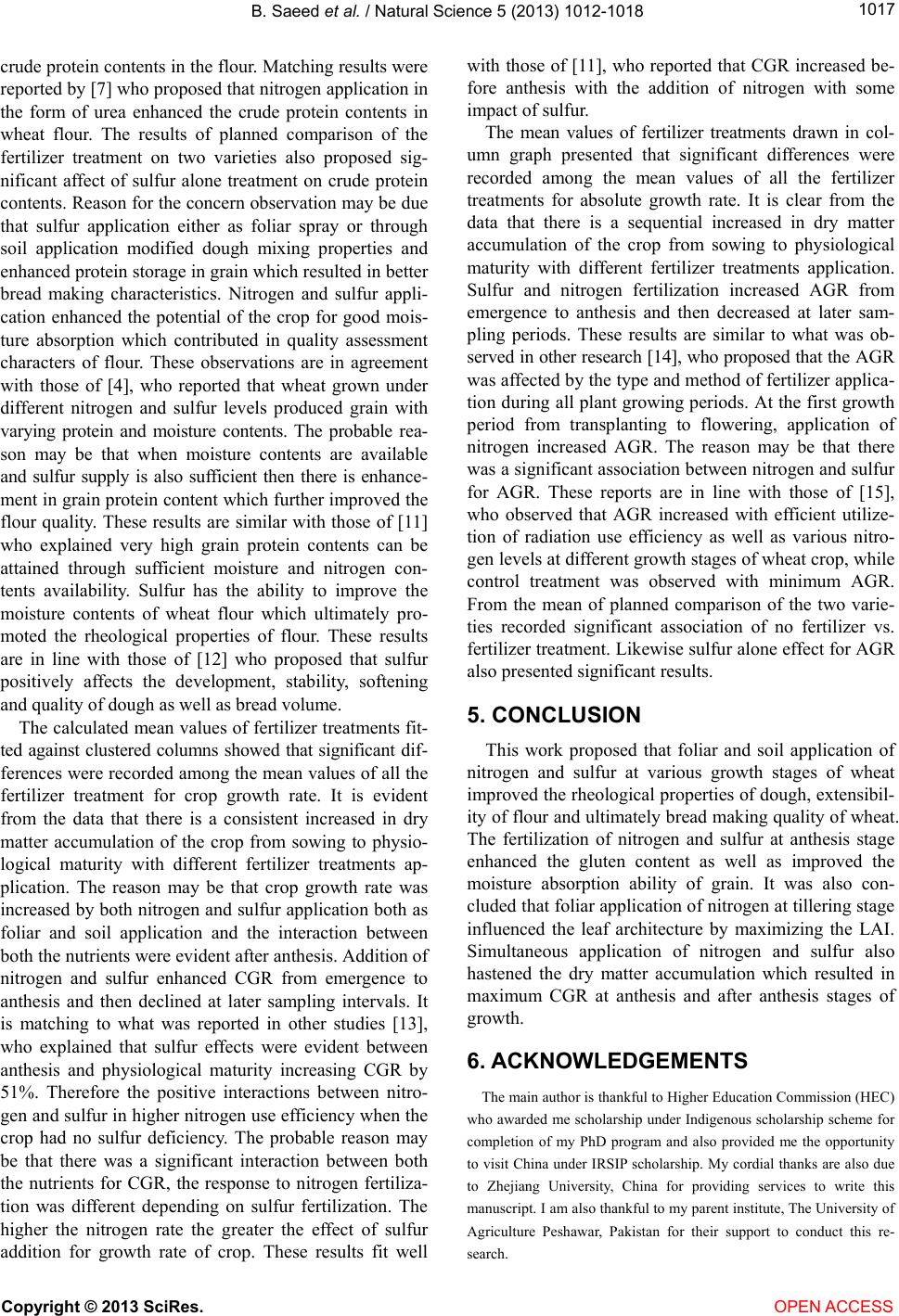
B. Saeed et al. / Natural Science 5 (2013) 1012-1018 1017
crude protein contents in the flour. Matching results were
reported by [7] who proposed that nitrogen application in
the form of urea enhanced the crude protein contents in
wheat flour. The results of planned comparison of the
fertilizer treatment on two varieties also proposed sig-
nificant affect of sulfur alone treatment on crude protein
contents. Reason for the concern observation may be due
that sulfur application either as foliar spray or through
soil application modified dough mixing properties and
enhanced protein storage in grain which resulted in better
bread making characteristics. Nitrogen and sulfur appli-
cation enhanced the potential of the crop for good mois-
ture absorption which contributed in quality assessment
characters of flour. These observations are in agreement
with those of [4], who reported that wheat grown under
different nitrogen and sulfur levels produced grain with
varying protein and moisture contents. The probable rea-
son may be that when moisture contents are available
and sulfur supply is also sufficient then there is enhance-
ment in grain protein content which further improved the
flour quality. These results are similar with those of [11]
who explained very high grain protein contents can be
attained through sufficient moisture and nitrogen con-
tents availability. Sulfur has the ability to improve the
moisture contents of wheat flour which ultimately pro-
moted the rheological properties of flour. These results
are in line with those of [12] who proposed that sulfur
positively affects the development, stability, softening
and quality of dough as well as bread volume.
The calculated mean values of fertilizer treatments fit-
ted against clustered columns showed that significant dif-
ferences were recorded among the mean values of all the
fertilizer treatment for crop growth rate. It is evident
from the data that there is a consistent increased in dry
matter accumulation of the crop from sowing to physio-
logical maturity with different fertilizer treatments ap-
plication. The reason may be that crop growth rate was
increased by both nitrogen and sulfur application both as
foliar and soil application and the interaction between
both the nutrients were evident after anthesis. Addition of
nitrogen and sulfur enhanced CGR from emergence to
anthesis and then declined at later sampling intervals. It
is matching to what was reported in other studies [13],
who explained that sulfur effects were evident between
anthesis and physiological maturity increasing CGR by
51%. Therefore the positive interactions between nitro-
gen and sulfur in higher nitrogen use efficiency when the
crop had no sulfur deficiency. The probable reason may
be that there was a significant interaction between both
the nutrients for CGR, the response to nitrogen fertiliza-
tion was different depending on sulfur fertilization. The
higher the nitrogen rate the greater the effect of sulfur
addition for growth rate of crop. These results fit well
with those of [11], who reported that CGR increased be-
fore anthesis with the addition of nitrogen with some
impact of sulfur.
The mean values of fertilizer treatments drawn in col-
umn graph presented that significant differences were
recorded among the mean values of all the fertilizer
treatments for absolute growth rate. It is clear from the
data that there is a sequential increased in dry matter
accumulation of the crop from sowing to physiological
maturity with different fertilizer treatments application.
Sulfur and nitrogen fertilization increased AGR from
emergence to anthesis and then decreased at later sam-
pling periods. These results are similar to what was ob-
served in other research [14], who proposed that the AGR
was affected by the type and method of fertilizer applica-
tion during all plant growing periods. At the first growth
period from transplanting to flowering, application of
nitrogen increased AGR. The reason may be that there
was a significant association between nitrogen and sulfur
for AGR. These reports are in line with those of [15],
who observed that AGR increased with efficient utilize-
tion of radiation use efficiency as well as various nitro-
gen levels at different growth stages of wheat crop, while
control treatment was observed with minimum AGR.
From the mean of planned comparison of the two varie-
ties recorded significant association of no fertilizer vs.
fertilizer treatment. Likewise sulfur alone effect for AGR
also presented significant results.
5. CONCLUSION
This work proposed that foliar and soil application of
nitrogen and sulfur at various growth stages of wheat
improved the rheological properties of dough, extensibil-
ity of flour and ultimately bread making quality of wheat.
The fertilization of nitrogen and sulfur at anthesis stage
enhanced the gluten content as well as improved the
moisture absorption ability of grain. It was also con-
cluded that foliar application of nitrogen at tillering stage
influenced the leaf architecture by maximizing the LAI.
Simultaneous application of nitrogen and sulfur also
hastened the dry matter accumulation which resulted in
maximum CGR at anthesis and after anthesis stages of
growth.
6. ACKNOWLEDGEMENTS
The main author is thankful to Higher Education Commission (HEC)
who awarded me scholarship under Indigenous scholarship scheme for
completion of my PhD program and also provided me the opportunity
to visit China under IRSIP scholarship. My cordial thanks are also due
to Zhejiang University, China for providing services to write this
manuscript. I am also thankful to my parent institute, The University of
Agriculture Peshawar, Pakistan for their support to conduct this re-
search.
Copyright © 2013 SciRes. OPEN ACCESS